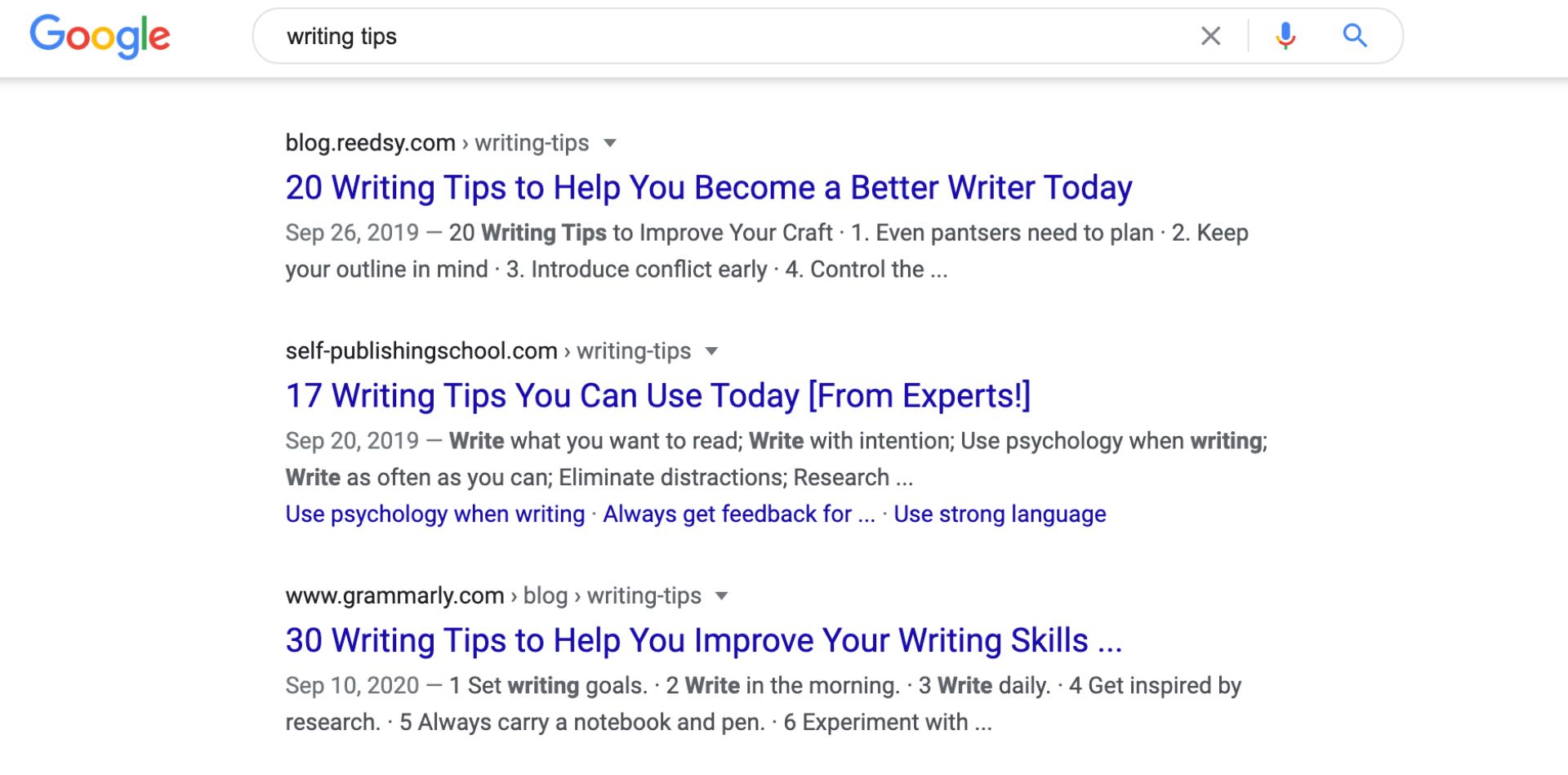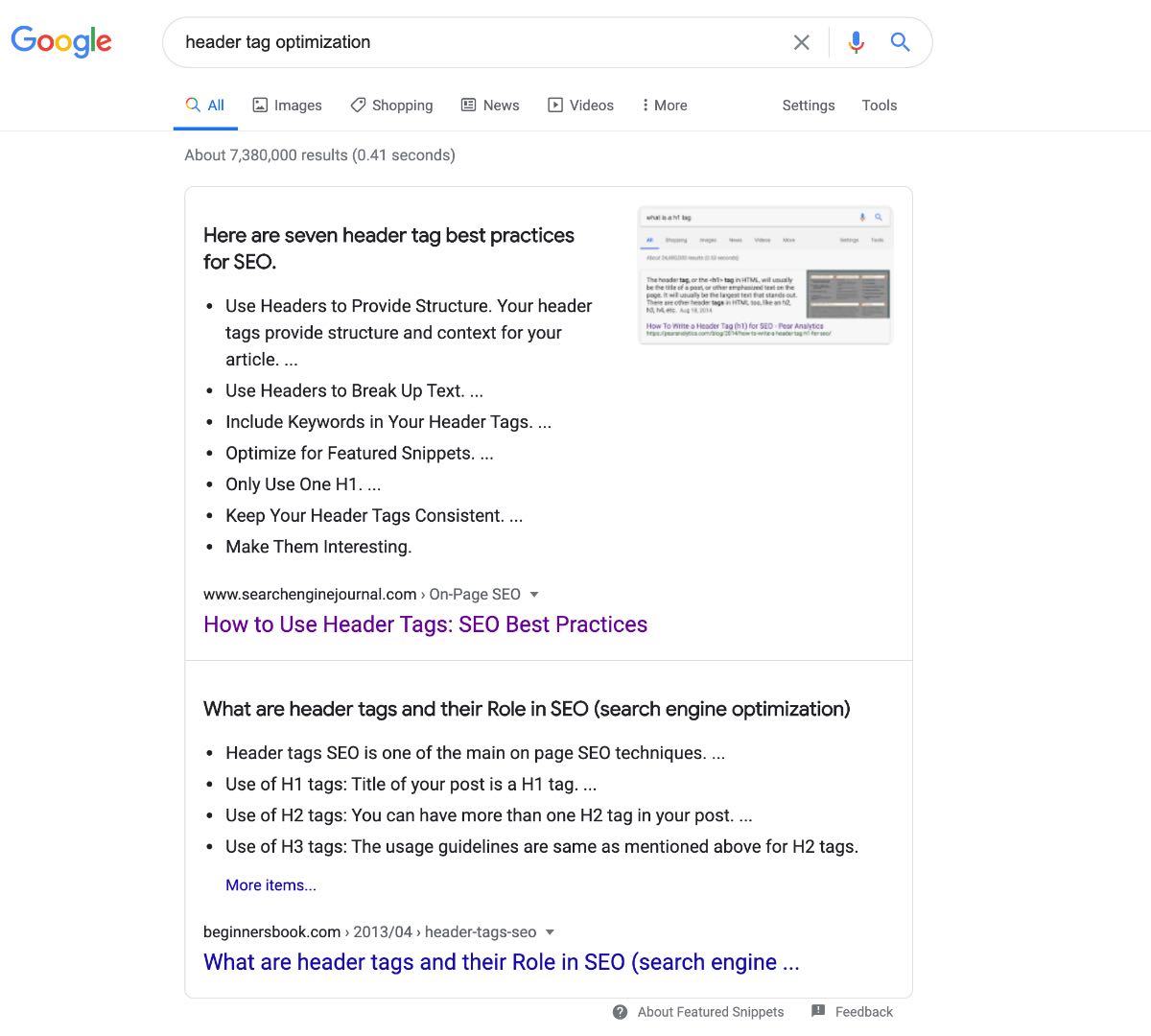As small businesses head into 2021 with endless hope that this pandemic ends, marketing dollars are scarce.
And from the looks of things, this marketing spend will continue its scarcity throughout 2021, especially if additional statewide or citywide shutdowns occur.
One advantage of this situation?
Refining your business website’s content writing with the latest trends of SEO in mind.
Many SMBs either have content writers and/or SEO professionals on staff, or work with digital marketing agencies.
Regardless of the situation, one thing you should not do during this pandemic is to become lazy.
My agency sees it over and over again, whether working with local environmental engineering firms or enterprise companies.
Many follow the digital marketing practices of the last decade, especially across their website content writing.
Throughout 2020, I not only revised my agency’s marketing and pricing strategies to cater to client needs – I also blocked time to focus additional energy on what content writing trends can further help clients succeed in SEO and brand awareness in 2021.
Advertisement
Continue Reading Below
This included looking at what worked for my clients throughout 2020, and what trends I had discovered.
The study helped shape a checklist for optimizing your website’s content writing using the latest SEO trends.
But first, a few content writing trend practices in regards to brand authority within a small business, and how to strengthen it through your website’s content.
2021 Content Writing Trends
In 2021, your brand authority will matter more than ever.
For most SMBs, the focus is on strengthening the overall company name itself versus the actual human being or beings behind the companies.
This is a mistake.
The more you can center a single person as the expert and authoritative figure that represents a business, the better.
Founders and CEOs typically follow this role, something familiar with giant corporations (think Howard Schultz, Elon Musk, or Tim Cook).
Most smaller businesses, though, have multiple voices representing their company.
This occurs across all marketing material, with the largest offender being the blog.
Advertisement
Continue Reading Below
If you have various experts on staff or freelancing for you, having separate authors for topics is ideal.
Take digital marketing agencies.
Experts in social media should write about social media, and experts in content marketing should write about content marketing, and, well, you get it.
The problem with many smaller businesses is they have only a few core services but continue to byline stuff as “staff” or even use fictitious names.
This provides zero identity to the company and doesn’t help the business build a strong following and repeated visits to that website.
The solution is to take one of these high authority figures within an SMB – again, typically a founder or CEO – and make them the voice of the content across that website.
The more niche the service or product, the more optimal it is to use a singular voice.
Think about a company selling stock investment services – would you trust the voice of the CEO or the voice of some unknown on the marketing staff?
With that said, it’s always smart to write in first-person pronouns.
Either “I” as the authoritative figure or “we” from the voice of the authoritative figure representing the company.
Back to digital marketing agencies.
Again, it’s wise to have experts writing on their specialized topics.
But also get the CEO involved.
This is where ghostwriting helps progress sales.
Even better is if the CEOs like to write and do the work themselves (or at least provide a bullet-point outline for your writer or agency).
Another trend I see is more traditional PR approaches such as media outreach, especially for those clients with a strong local base (think restaurants, auto service centers, massage therapy, etc.).
Local online and traditional news publications have much clout, and many of the reporters working for those publications are always on the hunt for local business angles.
Searching for more national media coverage?
Join HARO (Help A Reporter Out), one of the go-to tools of my ghostwriting services.
Advertisement
Continue Reading Below
2021 SEO Checklist for Content Writing
Now that I covered brand authority, it’s time to move into optimizing your website’s content following some trends for 2021.
The following speaks to both page and blog content.
All guidance derives from the trends I’ve witnessed with clients and other website rankings over the year, and I expect much of this to stick throughout 2021.
To keep things organized, I advise my writers to think SERP info first, then follow the page from top to bottom.
Begin with the title tag and meta description, and move down through the actual page as you would see it on the screen.
Following is the checklist for optimizing each content element as we throttle into 2021.
1. Keyword Research Optimization
All SEO professionals know that performing keyword research is the very first step in creating optimized content.
SEJ features hundreds of articles on performing keyword research so that I won’t go into crazy detail here.
But sadly many SMBs still refuse to perform any type of keyword research.
Advertisement
Continue Reading Below
This is normal for new clients at my agency who have never worked with an SEO pro before.
But, unfortunately, I also see a lack of keyword research for new clients who have worked with SEO professionals before.
If you neglect to perform keyword research, you’ll fail to garner any traction in the search results.
Here are some thoughts on keyword research trends as we head into 2021:
Target 80% Evergreen Keywords; 20% Trending Keywords
Take the time to truly understand the evergreen content needs of your market and audience, and target evergreen keywords for that content.
The goal is to have that content add value and solve the reader’s problems for many years into the future.
An example from a digital marketing agency: content writing tips, SEO basics, etc.
With that said, you also need to pay attention to trending keywords, such as the latest products available with your marketing.
An example from a digital marketing agency: how to optimize for voice search, predictive search, etc.
Advertisement
Continue Reading Below
And if you follow these trending keywords, and create authoritative content early enough, some may turn into evergreen keywords, and you’ll have a jump on the competition.
Create a Buyer Persona: Target Keywords & Content Towards That Buyer Persona
Spend time building out your buyer persona, and create an actual fictional character such as SEO pro Sarah.
- What would Sara be searching for?
- What keyword would attract her to your content?
- What type of CTAs will Sara engage with?
- How about imagery?
Don’t Go Crazy Over Volume
When you’re creating a constant flow of content, typically through a blog, don’t go crazy over only targeting high-volume keywords.
Depending on the ROI on a service or product, I’ll target keywords as low as 10-20 visitors per month.
I had a client who sold annual investing services with high guarantees worth around $4,000 yearly.
I targeted a few terms of around 20 search volume and sold eight of those annual services – $32,000 and all resigned through the following year.
Advertisement
Continue Reading Below
Not bad for a low-volume keyword target.
Monitor Keyword Performance Closely
We track client keywords through SEMrush, and if something’s not working as it should after around six weeks, we analyze the content and all of our target keyword positioning.
Sometimes a simple swap of words in a title tag helps with rankings.
Other times, it’s a complete overhaul of the content itself.
This is why it’s so vital to track progress and continually revamping older content throughout the year.
Don’t Forget About the Related Keywords
When I complete keyword research and have a target keyword that I’ll use for a page, I’ll also provide a list of related keywords for when I get to work.
Related keywords show more relevance to your topic, which helps send stronger signals about the page’s intentions for both search engines and readers.
 Which title tag above attracts your eye?
Which title tag above attracts your eye?2. Title Tag Optimization
David Ogilvy, the late Brit known as the “father of advertising” and founder of Ogilvy & Mather, said:
Advertisement
Continue Reading Below
“On the average, five times as many people read the headline as read the body copy. When you have written your headline, you have spent eighty cents out of your dollar.”
Though Ogilvy was a traditional advertiser, his guidance rings true for 21st century online marketing.
Title tags remain one of the strongest signals for search engines to explain what that page is about.
When writing title tags, they must not only engage humans but also satisfy SEO.
This is why the target keyword must be included in the headline.
The best practice is to have it as close to the front of the title as possible, and I’ve personally witnessed rankings change based on swapping around words in titles, something I explained above.
Other things to check off with regards to title tag creation are:
Keep It Short
The standard practice for SEO professionals is to create title tags between 50-60 characters because Google typically truncates everything after 60.
Advertisement
Continue Reading Below
But after a year of experimenting with various lengths, I try to write them shorter – like 40-50 characters.
This requires added energy from copywriters, but the effort is worth it.
Sometimes when creating a content strategy for clients and my workflow, I spend more time creating a list of optimized topics than writing a single 1,500-word article.
Feature Numbers
Recent statistics say that headlines featuring numbers (exact numbers of points such as 47 Content Writing Tips) get 36% more clicks.
Without a doubt use numbers where possible.
Use of Brackets or Parentheses
The same statistics say the use of brackets in titles increases click-through rates by 38%!
3. Meta Description Optimization
Here are the tips on optimizing meta descriptions in 2021:
Keep Them Shorter Than the Recommended 150-160
This is especially true for mobile.
We began experimenting with metas around 120-130 and observed increased click-through rates among various clients.
Think Free Advertisements
Think of these as a free way to advertise, and as a main supporter of your title tag.
Advertisement
Continue Reading Below
A good formula is the struggle/solution statement that entices a searcher to click.
Also, include a call to action with some “Words that Sell” (for more on that, read Richard Bayan’s Words that Sell).
Always Use Your Target Keywords in the Meta Descriptions
Though Google says meta descriptions have no direct ranking value, they certainly have an indirect ranking value.
If the target keywords are searched for, they will become bold in the meta descriptions, providing relevancy to the searcher’s intent.
This influences a clickthrough, indirectly affecting rank value.
Also, though Google might only be using your own meta descriptions about 3o% of the time and typically automatically populates them, it’s still the best practice to provide unique meta descriptions for every page across the website.
I’d argue even pages such as the privacy policy or contact pages, which are typically left to self populate.
4. Header Tag Optimization
Header tags are simply subtopics that break up the text and provide structure.
Advertisement
Continue Reading Below
These are especially effective in listicle articles where every number/section is the next section’s overall topic.
Most people scan when reading (link to study), and these header tags are the first thing people typically read.
Everyone wants to know what’s in it for them, and this makes that super simple.
They also are vital to ranking for featured snippets.
Google will typically take header tags and use them as bullets for a snippet.
The query “header tag optimization” provides the perfect example:

To optimize these in 2021:
Advertisement
Continue Reading Below
Use Target & Related Keywords
Always use your main keyword in at least one header tag and high-value related keywords in others.
Don’t Keyword-Stuff
Instead, infuse keywords naturally.
This should be easy if you outlined your content and set out to provide the most valuable information to the reader about the subject.
Keep Them Short
I’m saying as short as possible – six words or less.
Remember your audience is not dumb.
This section is about a checklist for optimizing content elements.
I don’t have to write “Optimizing header tags in 2021 based on current trends.”
Instead, “header tag optimization” suffices.
5. Internal Links/Image Optimization
Internal links within the text itself are vital for strong SEO.
They send strong signals to search engines about the relevance of another page on your website, and how you place value on that page.
Don’t Go Crazy With Internal Links
Instead, use them where a reader would naturally value the added content to learn more.
Advertisement
Continue Reading Below
Use a Strong Anchor Text
The goal here is to use an anchor text that includes the target keyword of the page being linked to.
This practice is all about sending the strongest signals possible to search engines and users about what you think is valuable information that supports the current page’s content.
As for images, remember – search engines can’t read an image (photo, PDF, etc.), hence why we use “alternative” text.
Here are quick pointers for 2021:
Each Image Should Have a Unique Title & Alt Text That Includes a Target Keyword
The latter is crucial because, according to Google, people search for over a billion images daily.
And if these images feature alt text that’s keyworded for the image search query, you’ll quickly discover other streams of traffic.
And for titles, nothing is worse for search engines than “Shutterstock – 2828923990213409858329.”
My agency places unique titles on all – even if they are the same we simply notate them by -1, -2, -3, etc.
Advertisement
Continue Reading Below
Use Captions Wherever Possible
I discovered simply adding captions to images at a motorcycle publication increased on-page time by over 20%.
Explain as much as possible, and don’t keyword stuff.
Here’s an ideal place to use related keywords, but only those related to the image.
Make sure to use italics to differentiate the text from the body of content.
Some content management systems don’t do a good job of this, so simple italics will work.
6. Body of Content Optimization
Following are some quick bullet points for optimizing the actual body of content on any page or blog:
Firs, Think About ‘Psychological’ Space
This means not writing long, Faulkner-type sentences or creating long paragraphs.
Short and choppy for the win, considering people scan content and will ignore anything that looks hard to read.
This is especially true on mobile!
Forget About the Keyword Density of a Target Keyword
Although many tools still exist for this purpose, forget about keyword density.
Advertisement
Continue Reading Below
Use your target keyword and your list of related keywords naturally throughout the content.
For 90% of my client blog/page work, I begin with the list of target and related keywords.
I glance through them before writing, and they usually show up automatically throughout my writing.
I still check the list during the editing stage and naturally infuse as many as possible throughout the text.
Sometimes a few related keywords don’t make sense, so I don’t use them.
Thoughts on Length
Regarding length, I’ve been experimenting for well over a year on this and getting some mixed signals from Google.
But one thing is for sure – longer is better for most situations.
For the main category and product pages, I target a minimum of 500 words.
Regarding blogs, the minimum is bumped to 1,200.
However, many land around 1,500 words, and for more intense subjects (such as articles for publications like Search Engine Journal), my minimum is 2,000 words (though they typically finish much longer).
Advertisement
Continue Reading Below
Two Dark Points
Here’s a quick checklist of two essential elements that should be included in every body of content across your website in 2021 – from service/product pages to blogs to about pages.
- Bullet Points.
- Bold/Italics.
Each element sends strong signals to search engines, explaining that readers and thus search engines, should pay attention because these elements are vital to the content’s message.

Concluding Thoughts
Heading into 2021, small businesses need to rethink their content writing habits across their business website(s).
Advertisement
Continue Reading Below
The process should place an equal amount of focus on SEO and brand authority.
The quickest way to the former is ongoing studies in SEO and experimentation across different content creation techniques (A/B testing headlines, adding more related keywords, testing meta descriptions, etc.).
As for brand authority, try creating all content from one authoritative voice in the company.
The best situation?
Have the CEO or founder be the voice behind every piece of content on the business website – homepage, service pages, product pages, blogs, or whatever.
They should also represent the company’s content marketing efforts across all other channels, from social media to third-party guest posting.
If not, the other best choice is the collective “we.”
Although again, “we” won’t have nearly as much power as a CEO or founder with a story to tell and the expertise to tell that story authoritatively using “I.”
Try a few of these techniques throughout 2021.
And if you have anything to add, please message me through my author page.
Advertisement
Continue Reading Below
I’m always collecting data for future stories here on Search Engine Journal.
More Resources:
Image Credits
Featured & In-Post Images: Unsplash
All screenshots taken by author, November 2020


